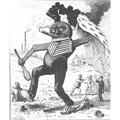| |
Introduction
As railroads grew in size, Americans began worrying about the power they wielded. By the 1870s, railroad owners controlled far-flung empires containing tens of thousands of employees and millions of dollars in assets. The nation's largest business enterprise was the Pennsylvania Railroad, which by 1873 boasted $39 million in capitalization, controlled 6,600 miles of rail line, and employed 200,000 men. Railroad owners used a variety of nefarious practices to increase their fortunes and gain an advantage over their rivals, including issuing watered-down stock, attempting to rig the stock market, and engaging in cutthroat rate wars. In the years after the Civil War, they also increasingly turned their economic power into political might, pushing state and federal legislatures for increased subsidies, more land grants, and protection from regulation and taxes. Railroads even influenced presidential elections. Thomas A. Scott, the president of the Pennsylvania Railroad, reportedly brokered the victory of Rutherford B. Hayes in the disputed election of 1876. Not surprisingly, Americans increasingly resented this and other abuses of power by railroad officials.
Echoing these concerns, Frank Bellew's cartoon, "The American Frankenstein," draws on Mary Shelley's 1818 novel about a monster that turns on its human creator. The caption reads, "Agriculture, commerce, and manufacture are all in my power. My interest is in the higher law of American politics."
Questions to Consider
Document

(click to enlarge)
Source:
Frank Bellew, "The American Frankenstein," New York Daily Graphic (14 Apr 1874). Downloaded from http://historymatters.gmu.edu/d/6755/.
Next >>>
<<< Return to Evidence
|